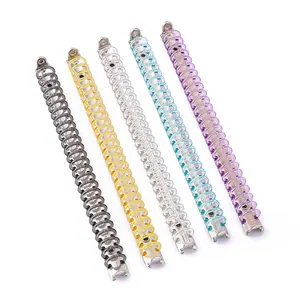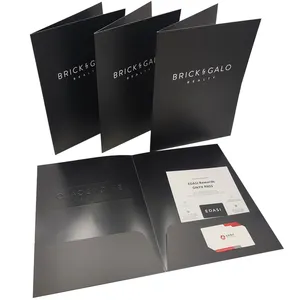
All categories
Featured selections
Trade Assurance
Buyer Central
Help Center
Get the app
Become a supplier

(5778 products available)




















































Binding folders are essential for keeping documents safely arranged, and each kind serves a particular purpose and situation. Common folder types include binding folders, presentation folders, and more, each designed to meet specific organizational needs.
As the name suggests, binding folders combine the functions of binding and storage. They are used to hold bound documents such as reports, theses, and proposals. There is a wide selection of binding materials available for various needs, including paper, plastic, PVC, metal combs, thermal glue, and wire combs.
A presentation folder is used to organize papers for seminars, interviews, and business presentations. Presentation folders generally include pockets for brochures or business cards and have a professional, customized appearance. They are often made from cardboard or heavier paper and can be printed with logos or designs.
Concertina folders are very useful as they have several (usually 6-13) partitions that enable one to sort documents by categories or months within one structure. They are ideal for everyday use and the systematic storage of an increasing number of documents in an office or school setting.
Pocket folders are two-panel documents with individual pockets that serve to hold loose sheets of paper, charts, and other thin materialship inserts. They are useful for keeping handouts tidy during conferences or teaching situations.
File folders are flat folders that contain a transparent plastic cover or are made of cardboard wherein single sheets of documents can be safely inserted. It is mainly used to shield individual papers or small documents from getting wet or losing shape.
Spiral and wire binding files are still the same as their name – they provide a protective folder for documents that have spiral or wire binding. These folders make it easy to transport bound books, reports, and manuals without damaging the pages or the binding. This kind of folder comes in different sizes for various binding designs, including PVC and plastic materials.
Choosing the right binding folder type depends on the occasion, required document protection level, and desired aesthetic or professional finish.Function of binding folders
Binding folders are more than just storage solutions for papers or even documents. Their functions, listed below, act as the protection, organization, and presentation of such materials.
With regard to protection, binding folders are in a position to safeguard documents from external elements such as moisture, dust, and physical wear and tear. This is particularly the case with presentation folders and binding folders, which may include a plastic covering or a rigid folder meant for storage, which effectively hinders the occurrence of damage to paper and its contents. Documents can, therefore, be protected from the above-mentioned climatic changes and even mishandling, thus retaining their readability and Over all appearance.
One of the important roles played by binding folders is the arrangement of documents in order to minimize the confusion experienced when trying to look for important documents sometimes. Various types of folders, such as accordions and pocket ones, can assist in grouping and categorizing documents, thus promoting easy retrieval. Some folders are provided with labels or tabs that enable sorting and naming of different materials in a specified collection incorporating distinct characteristics.
Good examples of documents that need to be presented are proposals, resumes, and marketing materials. Presentation folders and binding folders are ideally suitable for such documents in providing them with a professional appearance. If these documents are stored in neatly designed folders, they are more likely to create a positive impression on clients or employers in business or on potential customers in school settings.
Apart from that, binding folders perform the function of effective document storage, hence preventing loss or misplacement of any important document. An office environment, for example, is usually characterized by a high rate of document traffic, and binding folders assist employees in keeping their work-related documents intact and easy to locate.
To sum up, binding folders act as protection, arrangement, and professional presentation of documents and, thus, storage of information in a systematic manner to enhance efficient retrieval in time, creating impressions in required situations.
An understanding of the structure of binding folders, including the materials used, dimensions, and aesthetic-related features, such as colors and motifs, directly affects that and their usefulness and attractiveness.
Binding folders are manufactured using a wide variety of materials. Some of the more popular examples include plastic, paper, and cardboard; therefore, there are metal binding folders available. Plastic folders, for instance, may be further classified as folders made from PVC or polyethylene (PE) and are usually designed to be both flexible and durable. Plastic folders are also pockets or sleeves made from the same material to insert documents easily. Paper folders are, however, emphasized in their lightweight, more environmentally friendly material and in providing the user with a low-cost solution. These designs include those with corrugated cardboard that infers strength to pocket or presentation folders.
Pocket and accordion folders are structures that have been designed using stiff materials to prevent bending and to ensure that the documents contained do not get crumpled. The spine of these folders has been constructed to accommodate flexibility for procedures such as opening and closing the folder.
The size of binding folders is arguably another factor in their usefulness. Office and school files are primarily available in standard sizes, usually A4, letter size, or legal size. Nonetheless, there are also custom sizes available for certain uses, such as folders for small or large projects for multimedia productions or architectural designs. Binders (or Binding files) come in varieties with different numbers of pages to accommodate varying thicknesses of documents. This means that the higher the number of pages that the binder's spine can accommodate, the more documents will be organized.
Again, the exterior design of binding folders is important, especially in the case of presentation folders, more so when used for marketing or branding purposes. For instance, corporate entities may prefer their presentation folders to bear their corporate colors and logos. It does not matter whether it is a presentation folder or a binding folder; the creation of personal impressions can be done through the use of striking colors, images, or patterns.
An overview binding folder, including all types of folders, is a product developed through careful consideration of materials, sizes, and design to provide overall protection and efficient storage of documents while maintaining a visually appealing and professional outlook.
Selecting the appropriate binding folders requires a careful evaluation of factors such as purpose, volume of documents, and required sturdiness. The following aspects help guide this decision-making process.
The primary consideration when choosing a binding folder is what it will be used for. For example, presentation folders are ideal if the goal is to give out neatly arranged documents for a presentation, interview, or marketing purpose. These folders may be customized with a company name or logo to enhance brand visibility. However, if the goal is to store or transport documents requiring tight binding, such as reports or manuals, a binding folder made of plastic, cardboard, or paper might be more appropriate.
The number of documents that need to be organized or bound together will also determine the kind of folder used. Those that have a large number of documents or reports that need to be put together over time would require a binder with a large spine, while a small number of inserts or single sheets would be well fit for a pocket or sleeve folder.
Durability is key when documents are to be stored for long periods or handled frequently. In this case, plastic folders are available, which do not easily tear or water, alongside folders made of cardboard and paper that are stronger and stiffer, respectively, for resilience and sturdiness. Moreover, plastic binding folders tend to be more resilient against wear and tear when used frequently. A durable folder should be selected, accordingly, depending upon the usage frequency and period in the long term.
Customization options can also impact the folder selection. Printed or embossed folders allow for branding opportunities. Custom-colored folders can enhance visual appeal.
A1: A presentation folder is meant for organizing and showcasing loose documents, while a binding folder typically holds documents that have been formally bound together through various methods like comb binding or thermal binding.
A2: Yes, many suppliers of office materials offer businesses the option to customize binding folders through the inclusion of logos, brand colors, or specific messaging to make the folders representative of the company’s brand image.
A3: Binding folders are commonly made from materials such as PVC plastic, cardboard, or paper, each providing different levels of durability, flexibility, and cost-effectiveness.
A4: Binding folder sleeves are separate, transparent pockets made from plastic that can be inserted into a binding folder to hold individual sheets or small documents securely within the folder.
A5: The size of a binding folder affects its use by determining how many documents it can hold; larger binding folders are suitable for thicker collections of papers, while smaller ones are ideal for shorter documents or single reports.
A6: While many plastic binding folders are not environmentally friendly, as single-use plastic contributes to waste, there are now eco-friendly options available, including binding folders made from recycled paper or bioplastics, which address environmental concerns.